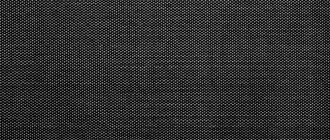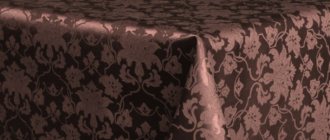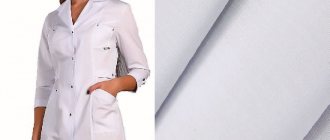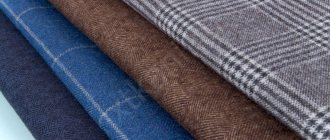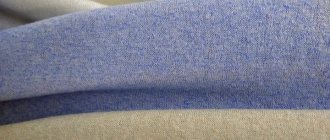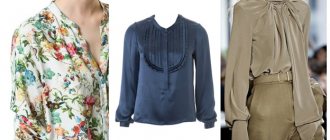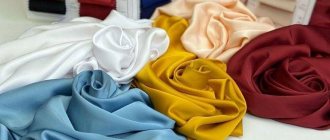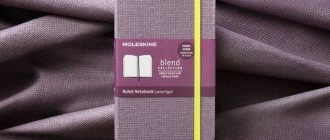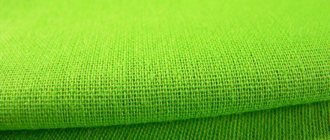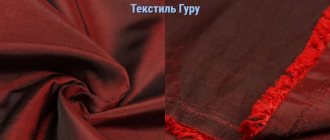Clothes are made from a variety of materials - openwork and transparent, dense and rigid. To make things fit comfortably to the body and last longer, use lining fabric. The material hides the back, seams, protects the wearer's skin and the main fabric, and also absorbs moisture.
Various fabrics are suitable for making linings: satin, polyester, mesh, chiffon and many other materials. Pure natural fabrics are used much less frequently, because synthetic fibers give the fabric strength and also reduce its cost. Natural cotton, linen and even silk are found in lining fabrics in varying percentages.
Atlas
Smooth, even fabric with a glossy silky surface - satin. This fabric is used to sew wardrobe items, make furniture upholstery and household textiles (curtains, bedding sets).
Satin is sometimes used as a lining
Satin was invented in China because the material was originally made from pure silk, which was not known in other parts of the world. Even today, when synthetics, viscose and cotton are used to make fabrics, satin remains a premium material.
The special glossy texture of the front side is obtained because during weaving, a large number of warp threads go around the weft. The fabric seems to be embroidered with microscopic satin stitch and therefore glides pleasantly.
Properties:
- density and smoothness;
- dimensional stability;
- wear resistance and strength;
- attractive appearance;
- safety and hygiene;
- the material is not electrified.
Satin is used as a lining for the following things:
- jackets, coats, fur coats;
- lining of men's suits;
- bags, wallets;
- gloves;
- curtains.
It is believed that satin is inferior to pure cotton and viscose as a lining - it is a delicate material, and also quite heavy. In addition, the fabric absorbs both moisture and dirt well, so it requires careful handling. Also among the disadvantages is the high price of the material.
Satin lining can be plain, decorated with prints, or with printed color designs.
How much does a meter of lining material cost?
The pricing policy is influenced by the country of origin, composition, width, and sometimes color (white fabric is cheaper than colored fabric) of the fabric. With mass production, it is more profitable to make wholesale purchases; for individual entrepreneurs, there is small wholesale.
The average price range is shown in the table
| Compound | Manufacturer | Cost (rub/m) |
| Cotton | Russia | 200-250 |
| Italy | 550-700 | |
| Silk | China | From 350 |
| Russia | From 500 | |
| Italy | From 470 | |
| Polyester | China | 50-210 |
| Russia | From 200 | |
| Italy | 400-550 |
Viscose
Viscose - the first artificial fabric
The world's first artificial fabric - viscose. It is made by processing wood pulp. The material cannot be called synthetic because it is not produced chemically. Viscose is used to make not only clothes (turtlenecks, dresses, blouses), but also washcloths and car tires.
To make viscose, wood fibers are converted into a liquid alkaline solution, which is then passed through special molds, bleached, and produced into fibers.
Advantages of the fabric:
- soft sliding;
- affordable price;
- not electrified;
- easy to paint;
- absorbs moisture (more than cotton);
- does not cause allergies.
Used for sewing:
- casual wear;
- tracksuits
- curtains
Viscose is hygroscopic and therefore suitable for creating summer clothes. The content of synthetic threads significantly increases the strength of the fabric, so you should not be afraid of their presence in the composition. The material also retains heat well, so it perfectly complements outerwear.
When caring for viscose, you should avoid aggressive cleaning agents and vigorous wringing and squeezing. The material does not like high temperatures - if it gets into boiling water or stays near an open fire for a long time, stains can form on the surface.
Cupro
In 1918, viscose fabric with the addition of copper-ammonia fibers was invented. It was called cupro or cupra. The material is based on wood (the basis for viscose) and natural cotton. This is an artificial fabric that resembles silk. Advantages of cupro:
- softness;
- strength;
- elasticity and resilience;
- color fastness (does not fade, does not fade);
- smoothness;
- hygroscopicity and breathability.
The lining with this material does not wrinkle. Cupro is used to complement the following products:
- coats and jackets;
- jackets, suits (classic men's clothing).
Cuprofibre is used in the manufacture of knitwear, brocade, velor, to create furniture upholstery and as a lining material. It is considered the most expensive type of viscose fabric.
Colors
The range of lining materials is impressive. In the production of clothing, not only the standard shades of white, black and blue are used. Red, pink, yellow and light green fabrics are often used. Double-sided lining fabric is in fashion and serves as an excellent decoration for any outerwear. Many coats and suits began to be sewn using multi-colored linings and patterned materials. They add character and style to the look.
Recently, the lining and the main fabric may not match in color and may be contrasting.
Polyester
Polyester is a synthetic knitted fabric that resembles wool. Polyester threads are made from polyester fibers.
Advantages:
- high strength;
- affordable price;
- low degree of creasing;
- resistance to light and heat;
- ease of care;
- antistatic.
Polyester lining is suitable for the following products:
- outerwear (jackets, coats, down jackets);
- haberdashery (bags, wallets, gloves);
- curtains.
The disadvantages of the fabric include poor breathability. Polyester does not absorb water well, it is not hygroscopic, so the material is often used to create winter clothes, as well as for interior textiles that will not come into contact with the skin.
Satin
The satin lining is pleasant to the skin.
Silk and cotton threads are used to produce satin. Thanks to a special weave, similar to satin, the fabric is smooth, with a soft shine, and very dense. To create the fabric, the warp threads are repeatedly overlapped with weft, forming a horizontal pattern. Satin is used to make clothes (shirts, dresses, light housecoats), cover shoes with fabric, and also use it as a lining.
Advantages of satin:
- reliable weight and thickness of the material;
- smooth, attractive surface;
- the fabric does not wrinkle, retains heat well;
- high resistance to abrasion.
Satin is expensive, so it is used to make spectacular, presentable things from valuable materials:
- lining of natural fur coats;
- addition to skirts, suits, jackets;
- curtains made of expensive materials (brocade, for example).
The satin lining decorates any item and does not cling to clothing. The fabric is easy to care for and does not require ironing.
Silk blanket
Silk is considered a very capricious filler. The natural material will tend to come out through the threads of the cover. As a result, it will stick to the body and cause serious discomfort.
To avoid such problems, you will need a special case. To do this, it is permissible to use durable cotton material, which is distinguished by dense weaving. Satin is best suited for this purpose.
An equally good solution would be silk fabric that holds the filler inside. This effect is achieved due to the special contact between silk fibers. A combination of cotton and silk threads will also securely fix the filler. In addition, the product will acquire a pleasant texture.
For a silk blanket, it is better to use cotton or silk fabric as the cover fabric.
Today there are many varieties of fabrics that are used to make blankets. To choose the appropriate option, you should take into account the structure of the filler and your individual feelings.
| Share: |
Similar materials
Net
Lining fabrics
A specially woven fabric with large spaces between the joined fibers is called mesh. The cell size can be different - small and large. The weft and warp threads are connected, twisting, and form strong knots that do not allow the cells to arbitrarily change size.
According to legend, the first tulle net was made by French craftsmen for the king’s bride. The material is made from synthetic threads (lycra and polyester), as well as viscose. Mesh is an airy, light, but at the same time rigid fabric. For lining, you should choose soft variations with the addition of natural fibers. This type of material also includes guipure, tulle and tulle.
Fabric properties:
- good breathability;
- maintaining the shape of the product;
- heat preservation;
- ease;
- ease of processing and care.
Used as a lining for the following items:
- tracksuits;
- wedding and ball gowns.
The rigid mesh allows you to create spectacular silhouettes of skirts, holds its shape perfectly, and has romantic folds. In addition, mesh is used to make stage costumes, summer and beachwear, interior decor, gifts, elegant items, pockets for backpacks and bags.
Taffeta (taffeta)
Translated from Persian, the word “taffeta” means woven material. Taffeta is a dense, even slightly stiff fabric with brittle folds and an iridescent glossy sheen on the front side. The weave of tightly twisted threads is plain (“thread through thread”). The fabric is made from silk, cotton and synthetics. Taffeta is used to make furniture upholstery, stage costumes, formal and everyday wardrobe items.
Advantages:
- softness, lightness and reliability;
- not electrified;
- plasticity and dimensional stability;
- water-repellent properties.
Used for sewing:
- linings for skirts and dresses;
- independent petticoats;
- curtains
Rigid varieties of taffeta are used to give volume and shape to the product. The material is also used to create wedding and evening dresses and fluffy petticoats, as well as bedspreads and decorative pillows. The material has few disadvantages: raw edges crumble, the fabric shrinks when washed, and wrinkles.
Flannel
Soft and warm woolen fabric was invented in the 17th century in Wales. They called the material flannel. Currently, fabric is also made from cotton, viscose and synthetics. Flannel is used to make robes, suits, shirts, bedding sets and warm linings.
Fabric properties:
- pleasant tactile sensations, softness, slight looseness;
- warms, retains heat;
- high strength and durability;
- hypoallergenic;
- hygroscopicity and good aeration.
There are also disadvantages:
- with prolonged use, the fabric rolls up and may wrinkle;
- hot water may cause shrinkage;
- flannel takes a long time to dry.
The material is used as a lining for the following products:
- baby clothes;
- stroller bags for babies;
- stroller lining;
- adult jackets, trousers.
Flannel protects well in cold weather, does not cling to other fabrics, and softly adheres to the body. This is a comfortable, warming material that only becomes softer after washing.
If the blanket is made of down
A duvet requires a durable cover from which hard feathers or fine fluff will not escape. Therefore, experts advise using materials that have “lint-retaining” characteristics.
It is best to use thick cotton fabric as a cover for a down duvet.
Such fabrics usually consist of tightly woven threads. They are often impregnated with a special compound that prevents fluff from coming out through the surface. The base composition is usually pure cotton. It reliably fixes the fuzz. This makes the blanket soft, breathable and easily absorbs moisture.
Chiffon
Chiffon
Airy, flying, translucent fabric is chiffon. The material was invented in China and was made from pure silk. In the first half of the twentieth century, chiffon began to be made from nylon polymer fibers, and then from polyester. There are several types of fabric: mother-of-pearl chiffon, chameleon, with lurex and spraying, crepe and jacquard.
Skirts, blouses, dresses are sewn from this material, and it is also used as a lining for delicate items.
Advantages of the material:
- softness and lightness;
- comfortable fit to the skin;
- the fabric does not wrinkle;
- good air exchange.
The following items can be found with a chiffon lining:
- skirts, sundresses and dresses;
- blouses;
- curtains and curtains.
Chiffon is finicky to process, and the transparency of the material requires careful seams. A carelessly sewn chiffon lining will quickly lose its integrity and render the item unusable.
For a wool blanket
The wool blanket has a natural composition and has healing properties. It has a warming effect, relieves pain in joints and muscle tissue, and improves skin condition.
However, wool blankets can be made from different fabrics. The most popular and in demand include the following:
- Sheep wool is considered the most affordable filler. It provides dry heat and is characterized by low thermal conductivity. The material helps retain internal heat. At the same time, it does not allow cold or heat outside. This means that products made from sheep wool provide an ideal microclimate during sleep.
- Camel wool - this material is characterized by excellent thermoregulation. Thanks to this, the product helps maintain a constant temperature. Camel wool has high hygroscopicity parameters. Thanks to this, it is always comfortable under a blanket made of such material. This even applies to people with excessive sweating.
- New Zealand sheep wool is characterized by a fine and soft texture and is considered to be of high quality. Products made from such material do not have a specific odor and retain their characteristics for a long time. This filler ensures a comfortable sleep.
Regardless of the type of wool, such a filler quickly warms, but is characterized by a rough structure. To avoid skin irritation, it is recommended to use a thick cotton cover. It is made from percale, twill or teak.
A wool blanket cover is made from percale, twill or teak.
Soft wool fluff goes well with thin materials. To do this, it is permissible to use satin or cambric. Such materials have a soft and delicate texture. Therefore, they can be safely used by sensitive people or children.
Quilted fabric
A stitch is a fabric stitched in a special pattern. Polyester is most often used. The stitch can be varied: rhombuses, squares, rectangles, floral motifs, even abstraction. This is a lightweight material, most often it hides some kind of filler, and the stitching helps keep it from migrating. Smooth polyester provides slip and the lining does not cling to clothing.
The following stitch types exist:
- curly;
- local;
- at intervals.
Application of Quilted Fabric:
- outerwear (jackets, down jackets, coats);
- bedding sets (bedspreads, pillows, blankets);
- bags.
Thanks to their density, quilted fabrics not only strengthen the back of the product, but also effectively insulate things. Decorative pillows and elegant bedspreads are also made from stitches.
How to choose a lining?
The lining is an additional fabric that helps keep the product in good condition, hides processing details (seams, for example), and fits nicely to the body. Different types of matter are used according to the situation. General requirements for lining fabrics look like this:
- the lining should be thinner than the base fabric;
- a smooth surface is necessary for easy sliding, so that clothes do not cling to other things and do not form puffs or snags;
- synthetic fabrics are more durable than natural ones and can withstand heavy loads, so you should not avoid them when choosing a lining;
- in many cases, the material should not be see-through to hide the underside;
- the lining should also be antistatic, hypoallergenic, breathable and very light so as not to make the item bulky.
A good lining retains its shape and does not wrinkle or deform when wet. Dense, smooth material hides seams well. Double-sided fabrics are perfectly complemented by mesh. The quality of the lining determines how long the product will last, be it a jacket or a bag.
Recently, linings have begun to be made bright, with colored patterns. This material decorates clothing if it has to be taken off in public (for example, taking off a coat in a cafe). A flying skirt accidentally lifted by the wind with a beautiful colored lining looks unusually flirty, and the same goes for long dresses.
Composition and properties of lining material
The fashion for elegant linings came from the Renaissance. Flirty young ladies, in order to stand out from the countless rows of pretty girls, ordered long silk petticoats for dresses - the lining of that time. Skirts also had a practical property - they hugged the body nicely, protecting them from the rough layer of outer fabric.
The gentlemen of the 16th century did not want to lag behind the ladies, skillfully demonstrating the expensive lining material of their cloaks. They raised their skirts when bowing or waved them in dance.
The famous fashion designer of the 19th century, Jeanne Paquin, used bright satin linings as an accent to set off a black coat.
Elegant outfits were created by Coco Chanel, adding a highlight to simple outfits - a lining lovingly sewn by hand. The wrong side has become the “face” of the brand, an integral part of the outfit.
Manufacturing technology
Modern lining materials are made from natural or artificial fibers. The tailor selects the fabric based on the product and its application. This way the lining of the skirt will be different from the inner fabric of the bag or coat.
When choosing fabric you should also consider:
- Shrinkage, tendency to stretch, other types of deformation.
- Ability to maintain appearance without wrinkles, even when wet.
- Density suitable for masking seams and roughness of the base material.
